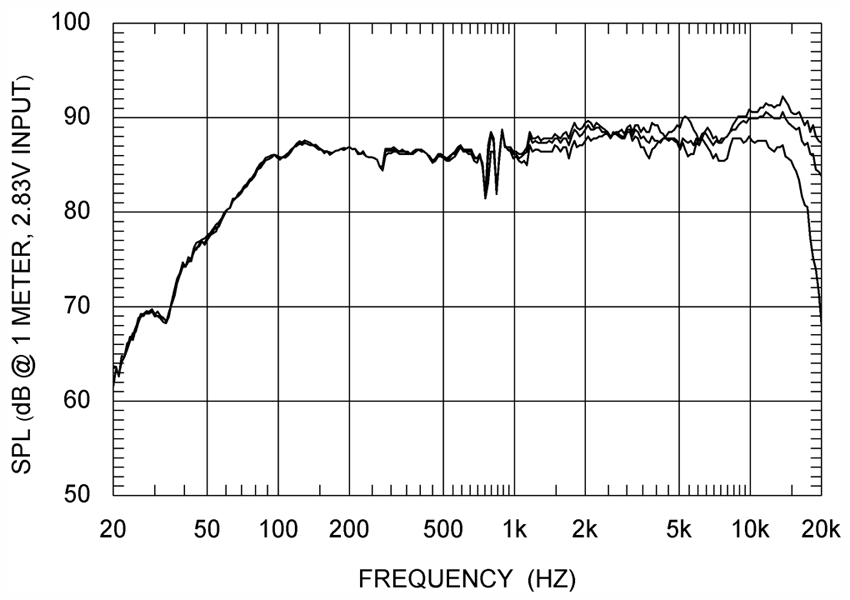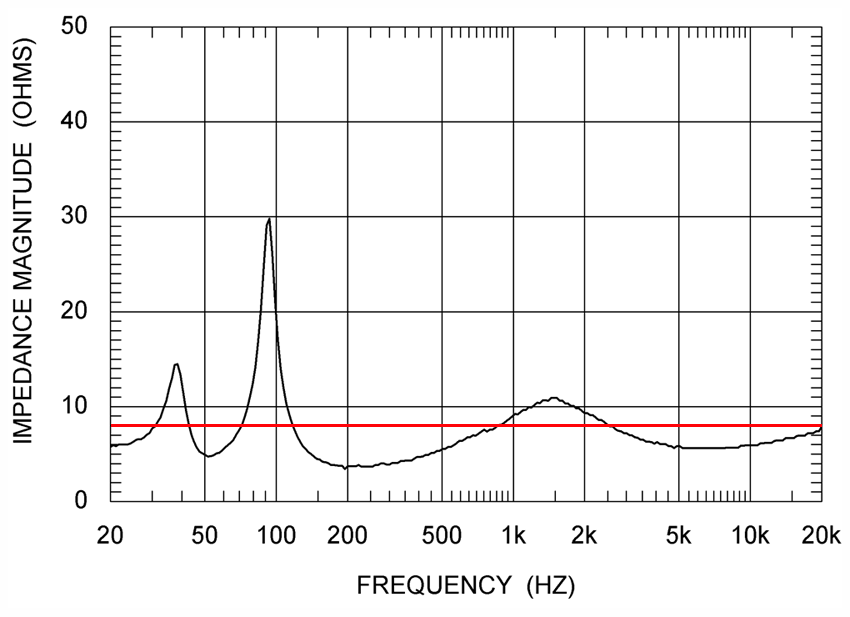 March 2010
When I Look at Loudspeaker Measurements . .
.
Are loudspeaker measurements
meaningful? There have been debates about this for decades, and I’ve seen nothing
recently that tells me that they won’t continue. On the one side are those who tell
you that such measurements mean almost everything. On the other are those who say they
mean almost nothing. The correct answer lies somewhere between these extremes.
I describe below what I look for at when I look
at loudspeaker measurements, and why I believe they’re meaningful -- something I was
reminded of last month, when I took a batch of speakers down to Canada’s National
Research Council (NRC) to be measured. For me, it comes down to five things:
1. Sound quality
Contrary to those who say measurements don’t tell you
anything about the sound a speaker will produce in a room, research by the NRC and others
has clearly shown that conventional speaker measurements, such as of frequency response, can
indicate what a speaker will sound like, particularly if the results include not just a
frequency-response measurement taken at a single point in front of the speaker, but
readings taken at many different points around it. The resulting "family of
curves" can be quite revealing of a speaker’s bandwidth, its tonal
characteristics, and its audible anomalies.
For instance, by looking at a graph of a speaker’s
frequency response you can learn how high and low the upper and lower frequencies extend,
respectively. The shapes of these curves (remember, you must look at many such curves, not
just one) will give you a sense of the speaker’s overall sound. A speaker with
"flat" frequency response both on and off axis is, in general, a neutral
speaker, meaning that it remains faithful to the signal fed it, and adds no colorations of
its own. That is the definition, in fact, of high fidelity. Speakers that have
frequency-response peaks will emphasize that part of the audioband, and dips in frequency
response will create a recessed sound in the corresponding frequency range. For instance,
if the area around, say, 1-2kHz is raised in level, midrange sounds such as vocals will
sound more pronounced, and these voices and other instruments will tend to move forward of
the plane described by the fronts of the speakers. If this area is depressed in the
frequency-response graph, the same voices and instruments will sound reticent, and the
musicians might sound slightly behind the plane of the speakers. Likewise,
emphasize the area about 10kHz and the speaker might sound bright, but deemphasize it too
much and the speaker could sound dull. It’s a delicate balancing act, but a
speaker’s frequency-response measurements can tell you a lot.

This chart shows three frequency-response measurements
for the Polk Audio RTi A1 loudspeakers that Aron Garrecht reviews this month: on
tweeter axis (top line at 20kHz), as well as 15- and 30-degrees horizontally off tweeter
axis (middle and bottom lines, respectively).
2. Design details
A frequency-response graph doesn’t only tell you how a
speaker will sound. If you become skilled at reading these graphs, you can spot cabinet
diffraction effects and driver and cabinet resonances, and you can assess the
drivers’ phase characteristics to see how well they sum acoustically. By looking at
the graphs of frequency response, impedance, and electrical phase, you can often spot the
crossover points, and if you can measure each driver’s output independently (i.e.,
if the speaker can be bi- or triwired), you can determine which crossover slopes the
designer chose. These things aren’t easy to correlate with what you hear, but they
can help you determine a lot about how a speaker has been designed. This can be useful to
reviewers, and to consumers who want to understand more about how loudspeakers work.
3. Verification of claims
Manufacturers will usually make claims about their
speakers’ performance that, presumably, are the results of measurements they’ve
taken themselves. For example, to give you an indication of what a speaker sounds like,
they’ll often specify its frequency response: how low it goes in the bass and how
high it goes in the treble. And to give you an idea of what kind of amplifier you’ll
need to drive it, they’ll specify such things as impedance and sensitivity. In a more
honest world, manufacturers’ claims could be taken at face value. As we’ve
learned over the years, many manufacturers’ claims are about as reliable as
politicians’ promises. But such embellishment can help make a sale, so there’s
good reason to double-check them.
The NRC is considered by many to be the gold standard of
speaker measurements, which is why we use them. To the best of our knowledge, no other
audio publication publishes measurements taken in a true anechoic chamber. If you
want to see how well the claims of speaker manufacturers hold up to scrutiny, bring up the
list of measurements we’ve produced -- they’re posted on the SoundStage! Network site -- and see
how they correlate with what’s stated in manufacturers’ brochures, spec sheets,
and websites.

The impedance plot for the RTi A1 not only
reveals the load that the speaker presents to the amplifier, but also various design
details. Polk Audio claims that the RTi A1 is a "nominal" 8-ohm load,
so we drew a red line on the chart at 8 ohms for reference. Impedance varies with
frequency but, if you look at the average, their 8-ohm claim seems reasonable.
4. Product safety
The tests we do at the NRC tell us other things that
aren’t so obvious, such as whether the speaker has been competently designed and is
safe to use. This is best illustrated with a recent example.
While measuring a speaker we had in for review, we found
that in two spots along the frequency range its impedance dipped to less than 1 ohm -- a
load so punishing that it could damage almost any amplifier. Were this speaker’s
impedance any lower, it would have been equivalent to a short circuit. Was this a sample
defect, or was it inherent in the speaker’s design? When we talked with the
manufacturer about it, it quickly became apparent that, in their design process, they
don’t measure their speakers at all. They asked us to return the speaker for an
"assessment at the factory." We did, but they never sent a replacement, so we
were never able to finish the review. Had we not first measured that speaker, it might
have destroyed the reviewer’s amplifier -- or a series of amps -- without us ever
knowing why.
5. Quality control
Even if a product is well designed, poor quality control --
i.e., how consistently a company can manufacture products that precisely match the
quality and specifications of the final prototype -- can be a big problem, and something
that measurements are useful for determining. For example, we don’t always measure
both of a pair of speakers; sometimes we ship, from the reviewer’s house or a
manufacturer’s facility, only one unit to the NRC. But when we do have both speakers
measured, I like to see if their results match. (We don’t publish the data in such
cases because we don’t always receive a pair, and we feel it fairest to publish only
those measurements that we can reliably produce for every speaker we review.) You’d
think the measurements of two ostensibly identical speakers would match, but they rarely
do -- almost all differ by at least a fraction of a dB, which means that the two speakers
of most pairs we’ve measured won’t sound exactly alike. But this
shouldn’t be surprising -- building a series of precisely identical speakers is very
difficult, due to the nature of the parts used. Even identical-looking drivers can have
surprisingly different frequency-response characteristics, if the way each is built
isn’t precisely the same as the other; and crossover components must be
meticulously checked to ensure that their tolerances remain correct.
But don’t let that fraction of a dB bother you too
much -- it doesn’t bother me, because it should not be audible. A mismatch becomes a
problem when the difference is greater -- much greater. More times than I’d like,
I’ve seen differences between speakers in excess of 1dB across an octave or two, and
sometimes as high as 3dB, or more. That you’ll definitely hear -- the
tonal balances of the speakers probably won’t be the same, and the speakers’
different output levels will mean that the pair’s soundstaging and imaging will
suffer.
I’ve noticed over the years that manufacturers that
heavily rely on proper measurement protocols during the design phase also use measurements
to ensure their products’ consistency and quality; and that those who don’t
do this during the design phase are also unlikely to do so in the verification stage.
It’s not only possible, but quite likely, that products from these latter companies
will have inconsistent sound.
Consensus?
Those who tell you that loudspeaker measurements mean
nothing probably don’t have a clear understanding of all the areas they can be used
for. When I look at measurements, I see a wealth of information that can be used to create
better reviews that will help readers make more informed buying decisions.
. . . Doug Schneider
das@soundstage.com
|

